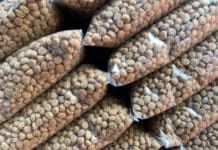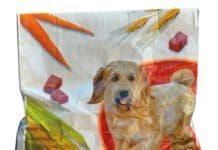How Retailers Can Help
Pet food manufacturers are fond of saying that their operations are highly regulated. It's true that regulations are in place that, in theory, protect consumers' dogs against poorly formulated products but it's also true that there is little surveillance and enforcement of the regulations. Rarely (and usually only in response to complaints) do regulators test to see if a food meets the guaranteed analysis for macronutrients on its label, and even more rarely, if it meets the standards for vitamins and minerals. So it's largely up to the market to look after itself.
High Pressure Processing in Raw Dog Food
Were you aware that, according to Federal law, it's okay for a certain percentage of the chicken you buy in the supermarket to contain some Salmonella bacteria? The legally acceptable amount depends on the kind of chicken we're talking about; if we're talking about whole raw broiler chickens, up to 9.8 percent could be infected, but if we're considering raw chicken parts, the number is even higher. In fact, up to 15.4 percent of the raw chicken parts may contain that pathogenic bacteria, without setting off any sort of recall or hysteria. In contrast, even a single positive test for Salmonella in raw dog food triggers a recall and headlines and a certain amount of hysteria among dog owners. What gives?
Dog Food Elimination Trials Are Worth The Effort
Allergies can literally cause a dog to tear his hair out, setting acute moist dermatitis (hot spots") into motion and triggering fits of paw-licking and head-shaking (caused by allergy-induced ear inflammation and infection). When this happens
Commercial Dog Food For Allergies
Owners who don't feel capable of or willing to carry out a rigorous trial may prefer to try a commercial dog food that has been processed in such a way as to render the proteins hypoallergenic, or one designed specifically for use in an elimination diet. Chances are good that your veterinarian carries at least one of these types of food. Some are limited-ingredient diets, available over the counter; others are prescription diets. All cost around 30 percent more than even the best nonprescription dog foods.
Whole Dog Journal’s Approved Dry Dog Food List 2015
but with the economy of scale and efficiencies of their large production facilities and ability to write big contracts with ingredient suppliers and you should be able to see that this is happening. Many of you don't trust the "big guys
Next-Level Selection Criteria
For some dog owners, a better dry dog food is just one more step on a journey to finding the healthiest diet in the...
About Dog Food Manufacturers and Co-Manufacturers
wholedogjournal_editorial
Some Well-Known Dry Foods, Ranked from Worst To Best
Worst (Top) to Best (Bottom)Kibbles 'n bits beef & chickencornsoybean mealbeef and bone mealground wheatanimal fat (BHA)protein 19%, fat 8%Pedigree Adultground whole grain cornmeat and bone mealcorn gluten mealanimal fat (BHA and citric acid)soybean mealprotein 21%, fat 10%Purina dog chow complete whole grain cornmeat and bone mealcorn gluten mealanimal fat (mixed tocopherols)soybean mealprotein 21%, fat 10%Beneful originalground yellow cornchicken byproduct mealcorn gluten mealwhole wheat flouranimal fat (mixed tocopherols)protein 25%, fat 10%
Your Dog’s Diet: A Dry Food Discussion
You know the old expression, It's better to teach someone to fish than it is to give them a fish"? We're ardent advocates of this approach. We would far rather teach a dog owner how to identify the good
5 Steps To Determine How Much To Feed Your Dog
Each and every one of the six people who adopted the puppies I fostered recently asked me the same question: How much should I feed him?" I was surprised the first time















